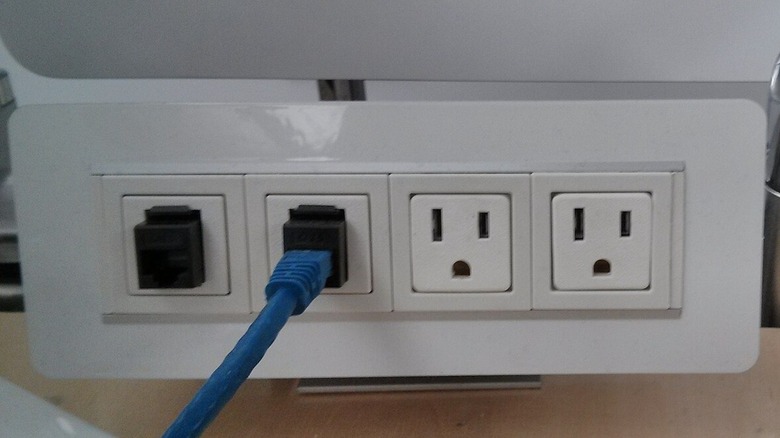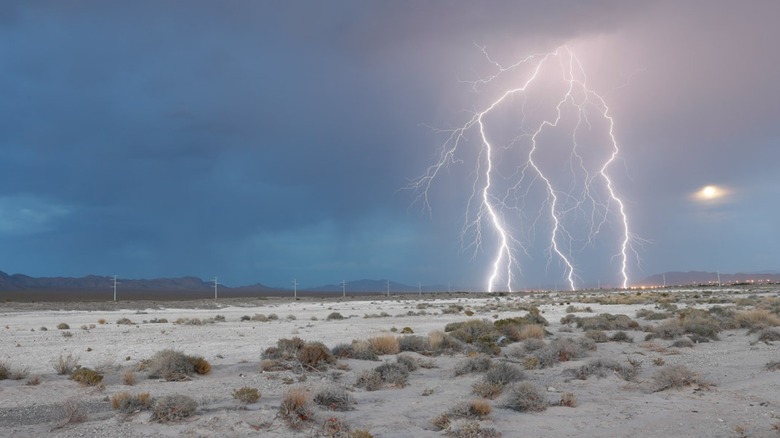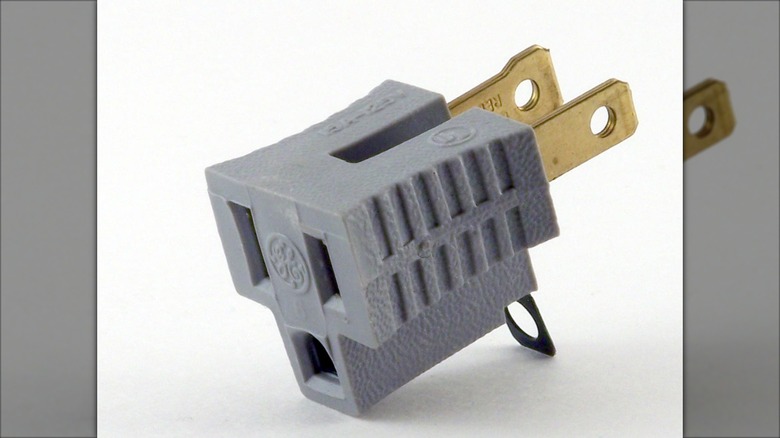Why Some Electrical Plugs Have Two Prongs (And Others Have Three)
It can be really frustrating when you're hooking up an appliance or gadget with a three-prong plug only to realize the extension cord or outlet you're plugging it into only has two prongs. After all, it's one thing for other countries to have different plug types, but why must American electrical systems use some plugs with two prongs and others with three? Shouldn't they be uniform across the board?
To answer this question, you first need to understand what electrical prongs are for — and why plugs need a minimum of at least two prongs. In modern homes, appliances and other devices with plugs draw electricity from the power grid by completing a circuit, which — as the name implies — consists of a loop that electricity safely travels across. Standard American outlets have at least two slots — the openings you plug into. The left slot is the neutral slot, where a neutral wire connects the outlet to your breaker box, which in turn connects your home to the power grid. The right slot is the hot slot, where a hot wire connects the outlet to the breaker box.
Electricity flows from the hot wire to the neutral wire — but only when the circuit is completed and the two are physically connected. That's what a two-prong plug does — with one prong inserted into each slot, electricity will flow from the hot wire into the appliance, giving it the power it needs, before completing the circuit by traveling back to the breaker box through the neutral slot and wire. Technically, appliances only need these two prongs to safely receive electricity and properly function. However, the third prong found on many, if not most American plugs, is still incredibly important.
The third prong of a plug grounds excess electricity in an emergency
All you need is to witness a lightning strike to see that electricity naturally seeks the ground — that's because the Earth acts as one giant neutral conductor and can absorb countless electrons without affecting its overall charge. Ground wires are thus important safety measures, as they provide a low-resistance path for excess electricity to reach the ground and safely dissipate. This principle is also why you should know how to ground yourself before touching delicate computer components.
Typically, electricity maintains equilibrium by flowing from the hot wire to the neutral wire in a power outlet, but if it's overwhelmed by a power surge or a faulty wire prevents electricity from reaching the neutral wire, a ground wire can serve as a backup and safely absorb the excess charge. Through the third slot in an outlet, the third prong on a plug connects to such a ground wire. The ground wire, like the neutral wire, safely brings electricity back to the breaker box. If electricity cannot reach the neutral wire and there is no safety ground wire, it will seek other ways to complete its circuit in ways that are unintended (which is, in effect, a short circuit).
This excess electricity can start fires within the wall or appliance. The charge can also travel into the metal casing of the appliance itself, which could cause a potentially fatal shock if you were to touch it, as the electricity would then continue its path through your body. Because of this, plugs of metal appliances include a third prong to safely ground excess electricity in this situation — although three-prong plugs have generally become much more common with all appliances across the board.
Is it safe to cut the third prong off a plug?
Some outlets are installed upside down, but the three prongs still serve the same purpose. Other outlets — especially older ones — only have two slots and can only fit two-prong plugs. Some power strips and extension cords may also only be compatible with two-prong plugs. If you're using a plug with a third ground prong, this can be frustrating, since you physically won't be able to plug it in — you might even be tempted to cut the third prong off so it fits. Because electricity only needs the hot and neutral prongs to complete the circuit through an appliance, a third prong technically isn't needed, and if you were to cut it off the plug, the appliance would likely still function.
However, this would be incredibly unsafe and you should never cut the third prong off a plug. Remember — the ground wire is explicitly there as a safety measure. Whether it's a power surge or a faulty wire, a short circuit can occur at any time, and if you remove access to the ground wire, electricity from the hot prong could travel to the appliance casing or elsewhere, potentially resulting in fires or dangerous shocks.
Adapters — also called cheater plugs — that allow you to connect three-prong plugs to two-prong outlets exist, but for the same reason, they're not totally safe to use. Higher-quality adapters may have extra insulation, but they still won't be able to conduct excess electricity to the ground wire if nothing connects to the third hole in the outlet. Some cheater plugs may have a metal tab that can ground electricity if correctly (and carefully) connected to compatible outlets, but many older two-prong outlets don't even have a ground wire in the first place.


